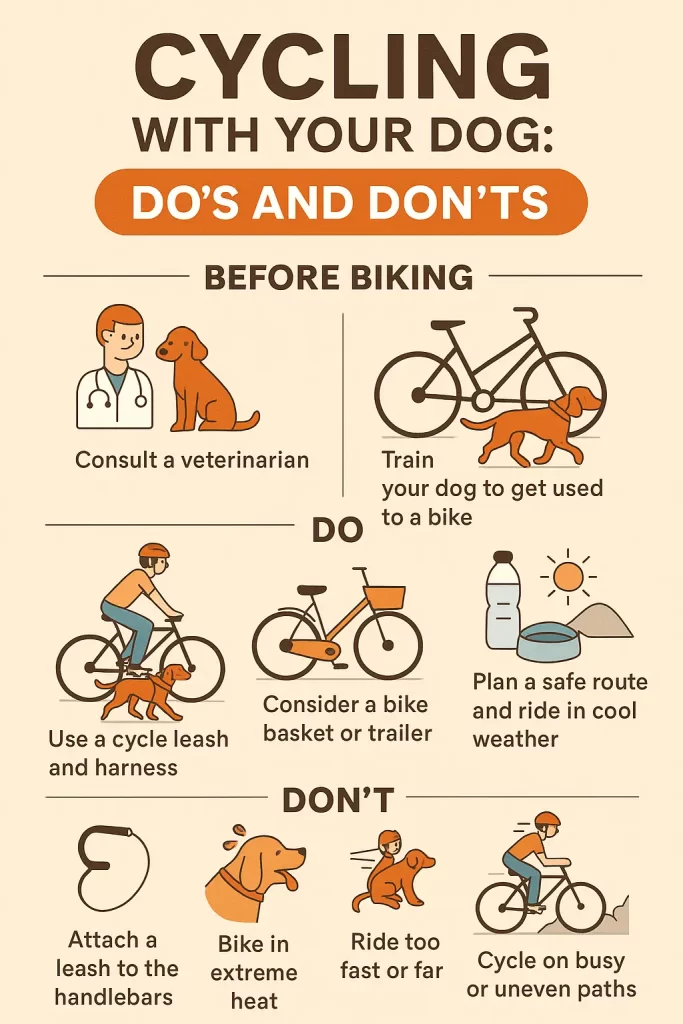Cycling with your dog can be an incredibly rewarding experience for both you and your canine companion. Whether you’re cruising around the neighborhood or exploring new trails, biking with a dog strengthens your bond while offering physical and mental stimulation. However, safety, preparation, and the right equipment are key to a successful outing.
1. Can All Dogs Ride Alongside a Bike?
Not all dogs are immediately ready to be your cycling partner. Large, athletic breeds such as Border Collies, Huskies, and Vizslas are typically well-suited for running beside a bicycle. However, smaller breeds or dogs with respiratory issues may be better suited for riding in a dog basket or bicycle trailer.
Always consult your veterinarian before starting any new exercise regimen, especially one as demanding as cycling. Young puppies, senior dogs, or those with orthopedic conditions should avoid strenuous runs.
2. Before You Hit the Road: Essential Prep Work
A. Health and Fitness Check
- Schedule a vet visit to ensure your dog’s joints, paws, and heart are up for the challenge.
- Introduce exercise gradually. Begin with short walks and light jogs before biking.
B. Desensitization to the Bike
- Let your dog sniff and walk alongside the stationary bike.
- Practice pushing the bike slowly while walking your dog beside it.
C. Leash and Command Training
- Use basic commands like “heel,” “stop,” and “leave it.”
- A no-pull dog bike harness or cycle leash for dogs helps keep your dog secure without choking.
Tip: Consider a biking dog leash designed to attach to the bicycle’s frame. This stabilizes your ride and keeps your hands free.
3. Choosing the Right Gear for Cycling With Dogs
| Equipment Type | Purpose | Recommended For |
|---|---|---|
| Dog Bike Leash Attachment | Keeps your dog safely beside the bike | Medium to large dogs |
| Dog Harness for Bicycle | Distributes pressure evenly, reduces injury risk | All breeds |
| Bicycle Dog Trailer | Ideal for small, injured, or senior dogs | Dogs that can’t run long distances |
| Dog Backpack or Front Basket | For carrying small dogs | Under 15 lbs dogs |
| GPS Tracker Collar | Tracks your dog’s location in real-time | All outdoor rides |
The P2 Smart GPS Tracker by SEEWORLD is particularly useful when biking with dogs off-leash or on rural trails. With health monitoring features and real-time tracking, it ensures your pet’s safety throughout the ride.
4. Road Safety Rules: Keep Your Dog (and Yourself) Safe
- Avoid riding in traffic or on hot pavement that could burn your dog’s paws.
- Always bring water for both you and your dog.
- Use reflective gear if riding during dusk or dawn.
- Check your dog’s paws before and after biking.
If you’re new to this, start with quiet bike paths or spacious parks. Gradually increase the speed and duration. Understanding how far your dog may roam is just as important for dogs as it is for free-roaming cats.
5. Cycling Options Based on Dog Size
A. For Larger, Athletic Dogs
- Use a secure biking leash for dogs to allow trotting alongside.
- Explore activities like bikejoring, a sport where dogs pull cyclists using special equipment.
B. For Small or Senior Dogs
- Opt for a dog in a bike basket or a bicycle dog trailer.
- Use a dog harness for bicycle baskets for stability and safety.
Related Read: How to Travel With a Cat – Road Trips & Flying Guide
6. Common Mistakes to Avoid
- Never tie a regular leash to your handlebars. It can cause you and your dog to crash.
- Don’t push your dog too hard. Watch for signs of exhaustion like panting, lagging behind, or limping.
- Avoid busy streets or unpredictable environments. Choose dog-friendly biking routes.
For longer rides or unfamiliar environments, a pet tracker gives you peace of mind. Learn how it compares with everyday tools like AirTags in this guide.
7. After the Ride: Care and Recovery
- Cool-down walk: Let your dog walk for a few minutes to bring down their heart rate.
- Hydrate: Offer fresh water and check for any injuries or soreness.
- Inspect gear: Check leash attachments and harnesses for wear.
For outdoor dogs, post-exercise care is crucial. Learn how to keep your pet safe and healthy outside with this complete guide.

Tips for cycling with dogs
Final Thoughts
Riding a bike with your dog can transform your daily routines into exciting adventures—if done safely. The right biking dog harness, a secure dog leash for biking, and proper training make all the difference. Whether your dog is running beside your wheels or comfortably watching the world from a trailer, cycling is a great way to explore, bond, and enjoy the outdoors together.
And remember—just like you wouldn’t ride without a helmet, your dog shouldn’t ride without a plan.



